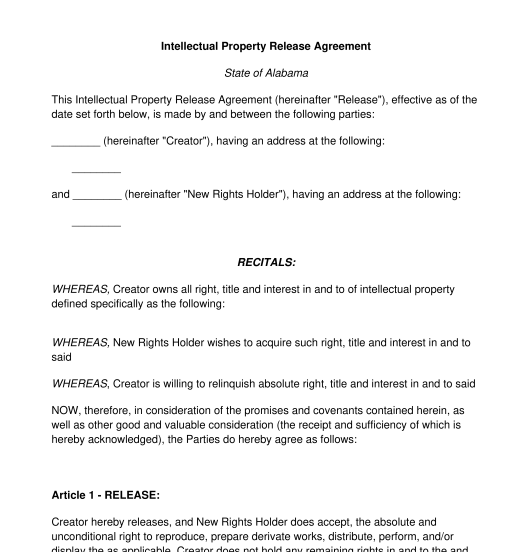 07/31/2025
07/31/2025

Answer a few questions and your document is created automatically.

Your document is ready! You will receive it in Word and PDF formats. You will be able to modify it.




Rating: 4.8 - 210 votes
Download a basic template (FREE) Create a customized documentAn intellectual property release form is a document used by someone who would like to release intellectual property (IP) they created, such as a work of art, piece of writing, or photograph, and give their rights to that IP to someone else. This type of agreement is used in situations where the creator is okay with the having no control over the IP or how it is used going forward. The party that receives the rights to the work is then free to use it as they would like to, including copying it, distributing it, or publishing it.
Though both documents involve intellectual property, they have different purposes. An intellectual property release is used when the owner of intellectual property would like to give away all the rights to their work to another party. The original IP owner does not receive continue compensation, called royalty payments, in exchange for transferring the IP. Once the intellectual property release is completed, the original intellectual property owner no longer has any rights to use the property.
A licensing agreement is used by the owner of the intellectual property to grant permission to someone else to use that property. There are often limits are how and for how long they may use the property. The property owner is typically compensated in exchange for the license. Even though the property owner grants a license to someone else to use the property, they still maintain total ownership.
No, it is not mandatory to use an intellectual property release form. An owner of IP may informally tell someone that they are free to use the property as they please going forward. However, by not using a release, both the IP owner and the other person are putting themselves at risk. The person using the IP is in danger of later being sued if the original IP owner changes their mind.
Before making an intellectual property release form, the potential new IP owner should do due diligence to be sure that the IP being offered is valid and enforceable. This can be done by finding patents, looking up trademark registrations, or identifying copyright verifications.
Once the intellectual property release form is complete and has been reviewed by both parties, both the original IP owner and the new IP owner should sign and date the contract. The document does not need to be notarized or witnessed to be legally binding. The parties should each save a copy of the release form in their files for future reference and in case of dispute or disagreement.
An intellectual property release form must include the following mandatory clauses:
There are no laws outlining what must be put into an intellectual property release form. Overall, intellectual property in the United States is covered under primarily federal law, with the main applicable statute being the Copyright Act of 1976. It is best practice to include as much detail about the work as possible, in the form, so that if a dispute should arise, the rights to the specific work are clear.
You fill out a form. The document is created before your eyes as you respond to the questions.
At the end, you receive it in Word and PDF formats. You can modify it and reuse it.
Intellectual Property Release Form - FREE - Template
Country: United States